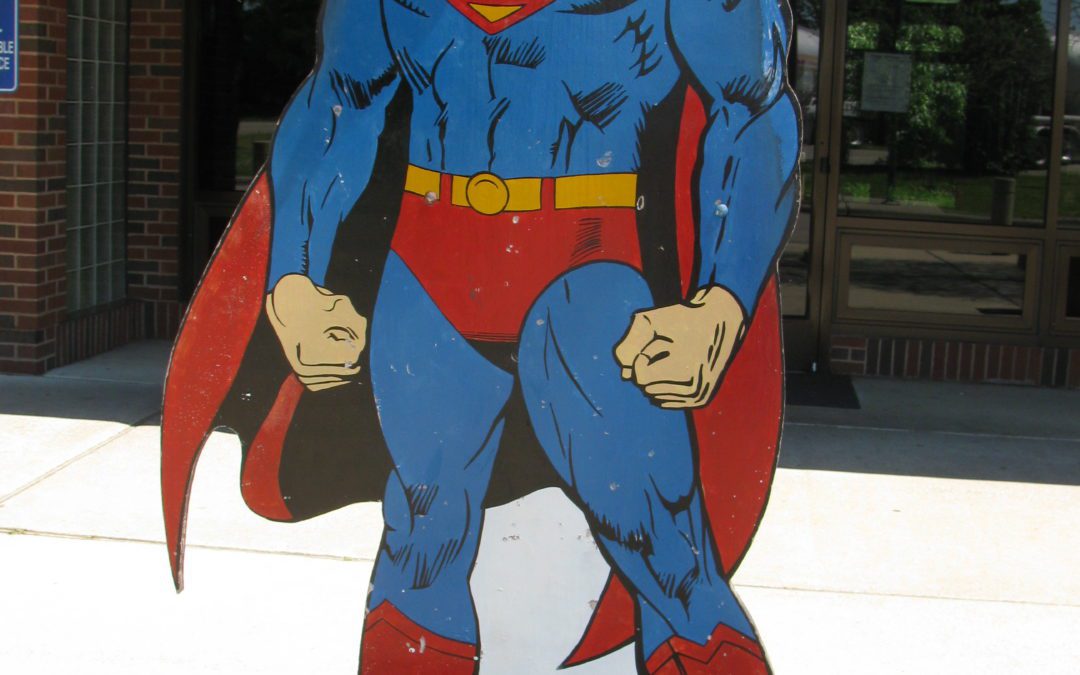Superman started out as a villain.
When two students from Glenview High School in Cleveland, Jerry Siegel and Joe Shuster, wrote a short story in the early 1930s about Superman, their new character was a villain who wanted to conquer the world. But within a year, Siegel (the writer of the pair) changed Superman to a hero we now know–an alien with super powers fighting for truth, justice, and the American way.
As an inspiration, Siegel and Shuster, both Jewish, drew upon the figures of Samson, of Biblical fame, as well as the Roman hero, Hercules.
They also drew considerable inspiration from the movies, naming Superman’s alter ego, Clark Kent, after two popular actors of the tim–Clark Gable and Kent Taylor. Superman’s city of Metropolis was inspired by the landmark silent movie, Metropolis.
All of the pieces were in place, but it would take six long years before they could convince any publisher to take a chance on Superman. Action Comics #1, with a cover date of June 1938, introduced Superman to the world–the first in a long line of superheroes that run and fly across our movie screens every summer.
In addition to the Samson influence, people have pointed to other Biblical connections in Superman. Biographer Larry Tye, for example, noted that Superman’s Kryptonian name, Kal-El, resembles the Hebrew words that mean “voice of God.”Â
Tye also compares Superman to Moses, who was set adrift in a basket when he was a baby, and went on to lead his people out of slavery. Superman’s parents saved him in a similar way, sending the baby Superman from Krypton in a vessel just in the nick of time before his home planet was destroyed.
And then there are the many comparisons to Jesus. Siegel and Shuster, both being Jewish, probably didn’t have Jesus in mind when they created their superhero, but Superman as a symbolic Christ figure has often been talked about. Most recently, the topic came up after the release of the latest Superman movie, Man of Steel. Here are just some of the parallels:
–When Clark Kent visits a priest, you can see the picture of Christ in the background, so Kent (Superman) is visually juxtaposed with Jesus in the Garden of Gethsemane.
–In a climactic battle, Superman is seen in mid-air with his arms outstretched, like Christ on the cross.
–Superman is described as being 33 years old, the age of Jesus when he was crucified.
–Superman is put in handcuffs, and he allows himself to be taken, even though he could easily break the shackles.
The Man of Steel director, Zack Snyder, openly admitted that the references were no accident. They knew they were making the comparison.
Even Samson–one of the inspirations for Superman–has been seen as a foreshadowing of Christ. When the Philistines captured Samson, they gouged out his eyes and chained him to two pillars in a pagan temple. Samson put his right hand on one pillar and his left hand on another pillar, symbolically putting him in the same pose as Christ on the cross, with outstretched arms. Then Samson used all of his strength to push down these pillars and bring down the temple dedicated to the god Dagon.
What all of these heroes tell us, both real-life heroes and the fictional ones, is that we all desire to be saved. I recently watched a Netflix presentation on the history of comic books, and I lost count of the number of times someone appeared on-screen talking about how superheroes meet the deep-seated need to have someone from on high rescue us in times of trouble.
That’s why superheroes flourish in periods of the greatest stress. Shuster and Siegel created Superman in the depths of the Great Depression, and superheroes reached peak popularity during World War II, during the advent of the Atomic Bomb, and in the aftermath of the 9/11 terrorist attack.
We all need saving. Superman probably rescued Lois Lane a hundred times by catching her in mid-air when she plummeted to earth. (Someone probably should have told Lois to stay away from ledges and windows.)
But falling is not just Lois Lane’s problem. The truth is that we have all fallen from grace. The Good News is that we all have Someone who is ready to catch us.
By Doug Peterson



